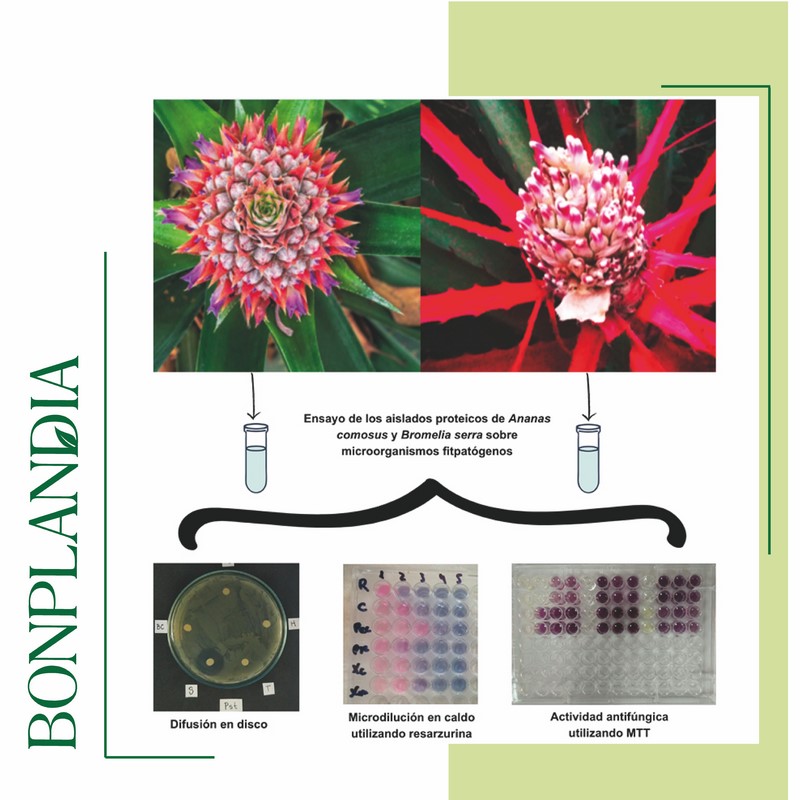Búsqueda de actividad biológica de aislados de fitoproteasas de Bromeliaceae nativas y cultivadas en Corrientes sobre microorganismos fitopatógenos
DOI:
https://doi.org/10.30972/bon.3417883Palabras clave:
Ananas comosus, Bromelia serra, control naturalResumen
El objetivo de este estudio es evaluar la actividad biológica de aislados proteicos de la planta nativa Bromelia serra (BS) y cultivada Ananas comosus (AC) sobre microorganismos fitopatógenos. Se obtuvieron muestras de bromeliáceas cultivadas (AC) del Campo Experimental de la Facultad de Ciencias Agrarias (UNNE) y de la bromeliácea nativa BS de montes naturales de la región. Se prepararon extractos de tallo y hojas de AC y hojas de BS, los cuales después de ser precipitados con acetona y obtener pellets, fueron resuspendidos en buffer estéril, los cuales se denominaron aislados proteicos. Se evaluó la actividad antimicrobiana frente a bacterias fitopatógenas mediante la técnica de difusión en disco. Sin embargo, no se observó la formación de un halo de inhibición en ninguno de los tratamientos con aislados proteicos, a diferencia del control positivo con estreptomicina. Se realizó la concentración inhibitoria mínima de crecimiento bacteriano por la técnica de microdilución en caldo. Los resultados mostraron que los aislados proteicos no inhibieron el crecimiento bacteriano. Además, se evaluó la actividad antifúngica contra Fusarium oxysporum mediante la técnica del MTT, pero tampoco se observó inhibición. Aunque los extractos de proteínas no mostraron actividad biológica contra los microorganismos evaluados, futuros experimentos continuarán la evaluación utilizando otros microorganismos. Además, una vez que se establezca un esquema de purificación, se utilizarán diferentes condiciones operativas y pruebas con enzimas puras en lugar de sus extractos.
Descargas
Citas
Abdulrahman Ali, A., Mohammed, A. M. & Isa, A. G. (2015). Antimicrobial effects of crude bromelain extracted from pineapple fruit (Ananas comosus (Linn.) Merr.). Advances in Biochemistry 3: 1-4. https://doi.org/10.11648/j.ab.20150301.11
Arshad, Z. I. M., Amid, A., Yusof, F., Jaswir, I., Ahmad, K. & Loke, S. P. (2014). Bromelain: an overview of industrial application and purification strategies. Applied Microbiology and Biotechnology 98: 7283-7297. https://doi. org/10.1007/s00253-014-5889-y
Ávalos-Flores, E., López-Castillo, L. M., Wielsch, N., Hupfer, Y., Winkler, R. & Magaña-Ortiz, D. (2022). Protein extract of Bromelia karatas L. rich in cysteine proteases (ananain-and bromelainlike) has antibacterial activity against foodborne pathogens Listeria monocytogenes and Salmonella Typhimurium. Folia Microbiologica 67: 1-13. https:// doi.org/10.1007/s12223-021-00906-9
Caffini, N. O., Natalucci, C. L., Priolo, N. S., & Buttazzoni, M. S. (1988). Proteasas de Bromeliaceae. IV. Aislamiento de una fitoproteasasulfhidrílica presente en frutos de Bromelia serra Griseb. Acta Farmacéutica Bonaerense 7: 9-14.
Culebras, J. M. & Franco-López, Á. (2016). Negativo es positivo. Medicina y Seguridad del Trabajo 62: 290-292. De Pooter, H. L., Aboutabl, E. A. & El‐Shabrawy, A. O. (1995). Chemical composition and antimicrobial activity of essential oil of leaf, stem and rhizome of Alpinia speciosa. Flavour and Fragrance Journal 10: 63-67. https://doi.org/10.1002/ffj.2730100202
Demo, M., Oliva, M. D. L. M., López, M. L., Zunino, M. P. & Zygadlo, J. A. (2005). Antimicrobial activity of essential oils obtained from aromatic plants of Argentina. Pharmaceutical biology 43(2): 129-134. https://doi.org/10.1080/13880200590919438
Dickert, H., Machka, K. & Braveny, I. (1981). The uses and limitations of disc diffusion in the antibiotic sensitivity testing of bacteria. Infection 9: 18-24. https://doi:10.1007/bf01640803
Dutta, S. & Bhattacharyya, D. (2013). Enzymatic, antimicrobial and toxicity studies of the aqueous extract of Ananas comosus (pineapple) crown leaf. Journal of Ethnopharmacology 150: 451-457. https://doi.org/10.1016/j.jep.2013.08.024
Ghannoum, M. A. & Rice L. B. (1999). Antifungal agents: mode of action, mechanisms of resistance, and correlation of these mechanisms with bacterial resistance. Clinical Microbiology Reviews 12: 501- 17. https://doi.org/10.1128/CMR.12.4.501
Gómez Herrera, M. D., Luaces, P. A., Liggieri, C., Bruno, M. & Avanza, M. V. (2022). Proteolytic characterization of a novel enzymatic extract from Bromelia serra leaves.Anais da Academia Brasileira de Ciências 94:1-15. https://doi.org/10.1590/0001- 3765202220201871
Hassan, O. & Chang, T. (2017) Chitosan for ecofriendly control of plant disease. Asian Journal of Plant Pathology 11: 53-70. Hood, J. R., Wilkinson, J. M. & Cavanagh, H. M. A. (2003). Evaluation of common antibacterial screening methods utilized in essential oil research. Journal of Essential Oil Research 15: 428-433. https://doi.org/10.1080/10412905.2003. 9698631
Husain, Q. (2018). Nanocarriers immobilized proteases and their industrial applications: an overview.Journal of Nanoscience and Nanotechnology 18: 486-499. https://doi.org/10.1166/jnn.2018.15246
Jung, Y. J., Choi, C. S., Park, J. H., Kang, H. W., Choi, J. E., Nou, I. S., Lee, S. Y. & Kang, K. K. (2008). Overexpression of the pineapple fruit bromelain gene (BAA) in transgenic Chinese cabbage (Brassica rapa) results in enhanced resistance to bacterial soft rot. Electronic Journal of Biotechnology 11: 71-79. http://dx.doi.org/10.4067/ S0717-34582008000100007
Kuhn, D. M., Balkis, M., Chandra, J., Mukherjee, P. K. & Ghannoum, M. A. (2003). Uses and limitations of the XTT assay in studies of Candida growth and metabolism. Journal of Clinical Microbiology 41: 506-508. https://doi.org/10.1128/jcm.41.1.506- 508.2003
Laemmli, U. K. (1970). Cleavage of structural proteins during the assembly of the head of bacteriophage T4. Nature 227: 680-685.https://doi. org/10.1038/227680a0
Lambir, A. J., Carezzano, M. E., Quiroga, P. R. & Grosso, N. R. (2022). Fracciones de aceite esencial de laurel obtenidas por destilación molecular con mayor actividad antioxidante y antimicrobiana. AgriScientia 39: 105-116. https:// doi.org/10.31047/1668.298x.v39.n1.35407
López‐García, B., Hernández, M. & Segundo, B. S. (2012). Bromelain, a cysteine protease from pineapple (Ananas comosus) stem, is an inhibitor of fungal plant pathogens. Letters in Applied Microbiology 55: 62-67. https://doi.org/10.1111/ j.1472-765X.2012.03258.x
Manzoor, Z., Nawaz, A., Mukhtar, H. & Haq, I. (2016). Bromelain: Methods of extraction, purification and therapeutic applications. Brazilian Archives of Biology and Technology 59: 1-16. https://doi. org/10.1590/1678-4324-2016150010
Mazorra-Manzano, M. A., Ramírez-Suarez, J. C. & Yada, R. Y. (2018). Plant proteases for bioactive peptides release: A review. Critical Reviews in Food Science and Nutrition 58: 2147-2163.https://doi.org/ 10.1080/10408398.2017.1308312
Meena, R. K. & Mishra, P. (2020). Bio-pesticides for agriculture and environment sustainability. En Kumar, S., Meena, R.s. & Jhariya, M.k. (eds.), Resources use efficiency in agriculture, pp. 85-107.Springer Press, Singapur. https://doi. org/10.1007/978-981-15-6953-1_3
Meletiadis, J., Meis, J. F., Mouton, J. W., Donnelly, J. P. &Verweij, P. E. (2000). Comparison of NCCLS and 3-(4, 5-dimethyl-2-thiazyl)-2, 5-diphenyl-2Htetrazolium bromide (MTT) methods of in vitro susceptibility testing of filamentous fungi and development of a new simplified method. Journal of Clinical Microbiology 38: 2949-2954. https://doi.org/10.1128/jcm.38.8.2949-2954.2000
Pinheiroa, A. C., Bourbona, A. I., Cerqueiraa, M. A., Maricato, E., Nunes, C., Coimbra, M. A. & Vicentea, A. A. (2015). Chitosan/fucoidan multilayer nanocapsules as a vehicle for controlled release of bioactive compounds. CarbohydrPolym 115: 1-9. https://doi.org/10.1016/j.carbpol.2014.07.016
Präbst, K., Engelhardt, H., Ringgeler, S., Hübner, H. (2017). Basic Colorimetric Proliferation Assays: MTT, WST, and Resazurin. En Gilbert, D. & O. Friedrich (eds.) Cell viability Assays. Methods in Molecular Biology, vol. 1601. Humana Press, New York, NY. https://doi.org/10.1007/978-1-4939-6960-9_1
Prieto, M. C., Lapaz, M. I., Lucini, E. I., Pianzzola, M. J., Grosso, N. R., Asensio, C. M. (2020). Thyme and suico essential oils: promising natural tools for potato common scab control. Plant Biology 22: 81-89.
Salese, L., Liggieri, C. S., Bernik, D. L. & Bruno, M. A. (2022). Characterization of the fruit proteolytic system of Bromelia serra Griseb. (Bromeliaceae) and its application in bioactive peptides release. Journal of Food Biochemistry 46: e14016. https://doi.org/10.1111/jfbc.14016
Sarath, G., De La Motte, R. & Wagner, F. 1989. Protease assay methods. En Beynon R. & J. Bond (eds.), Proteolytic enzymes: a practical approach, pp. 25-55. IRL Press, Oxford.
Tochi, B. N., Wang, Z., Xu, S. Y. & Zhang, W. (2008). Therapeutic application of pineapple protease (bromelain): a review. Pakistan Journal of Nutrition 7: 513-520. https://doi.org/10.3923/pjn.2008.513.520
Xu, X. M., Jeffries, P., Pautasso, M. & Jeger, M. J. (2011). Combined use of biocontrol agents to manage plant diseases in theory and practice. Phytopathology 101: 1024-1031. https://doi. org/10.1094/PHYTO-08-10-0216

Descargas
Publicado
Versiones
- 2025-05-22 (6)
- 2025-05-22 (5)
- 2025-02-24 (4)
- 2024-12-17 (3)
- 2024-11-12 (2)
- 2024-10-30 (1)
Cómo citar
Número
Sección
Licencia
Derechos de autor 2024 Bonplandia

Esta obra está bajo una licencia internacional Creative Commons Atribución 4.0.
Declaration of Adhesion to Open Access
- All contents of Bonplandia journal are available online, open to all and for free, before they are printed.
Copyright Notice
- Bonplandia magazine allows authors to retain their copyright without restrictions.
- The journal is under a Creative Commons Attribution 4.0 International license.














.jpg)


